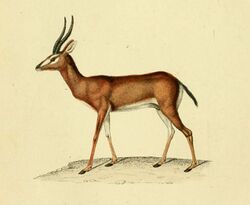Biology:Saudi gazelle
| Saudi gazelle | |
|---|---|

| |
| Scientific classification | |
| Domain: | Eukaryota |
| Kingdom: | Animalia |
| Phylum: | Chordata |
| Class: | Mammalia |
| Order: | Artiodactyla |
| Family: | Bovidae |
| Subfamily: | Antilopinae |
| Tribe: | Antilopini |
| Genus: | Gazella |
| Species: | |
| Subspecies: | †G. d. saudiya
|
| Trinomial name | |
| Gazella dorcas saudiya Carruthers & Schwarz, 1935
| |
| Synonyms | |
|
Gazella saudiya | |
The Saudi gazelle (Gazella saudiya) is a Gazella species that was once native to the Arabian Peninsula. It was declared extinct in the wild in 1996, as it was last observed in the wild in 1970.[1] The Saudi gazelle was officially declared extinct on the IUCN Red List in 2008.
Taxonomy
Gazella gazella saudiya was the scientific name proposed by Douglas Carruthers and Ernst Schwarz in 1939. They described the skull and head skin of a male gazelle specimen collected at an elevation of 1,100 m (3,500 ft) near Dhlam in Saudi Arabia.[2] Terence Morrison-Scott recognised it as a distinct species Gazella saudiya in 1939.[3] Colin Groves examined horn shapes and sizes of zoological specimens of gazelles and recognised the Saudi gazelle as a subspecies of the Dorcas gazelle Gazella dorcas saudiya in 1969.[4]
Phylogenetic analysis of museum samples of the Saudi gazelle revealed that it is distinct from and a sister taxon of the Dorcas gazelle.[5]
Distribution and habitat
The Saudi gazelle once lived in gravel and sandy plains with acacias of the northern and western Arabian Peninsula from Kuwait to Yemen, with most of the records coming from western Saudi Arabia. It was found singly or in groups up to 20.[1]
Decline and extinction
The subspecies had always been rare and declining due to excessive hunting; it had not been seen for a few decades, and was declared to be extinct in the wild in 1980. Recent genetic analysis of all reported specimens of G. d. saudiya in captive collections has shown these represent different species or hybrids.[1][5] Despite frequent surveys attempting to find pure Saudi gazelles in the wild and privately owned, no evidence of surviving individuals has been found. In 2008, the Saudi gazelle was officially declared extinct on the IUCN Red List.
See also
References
- ↑ 1.0 1.1 1.2 1.3 IUCN SSC Antelope Specialist Group (2016). "Gazella saudiya". IUCN Red List of Threatened Species 2016: e.T8980A50187890. doi:10.2305/IUCN.UK.2016-3.RLTS.T8980A50187890.en. https://www.iucnredlist.org/species/8980/50187890. Retrieved 28 September 2021.
- ↑ Carruthers, D.; Schwarz, E. (1939). "On a new gazelle from Central Arabia". Proceedings of the Zoological Society of London 105 (1): 155–156. doi:10.1111/j.1469-7998.1935.tb06237.x.
- ↑ Morrison-Scott, T. C.S. (1939). "Some Arabian Mammals collected by Mr. H. St. J. B. Philby, C.I.E". Novitates Zoologicae 41 (3): 181–211. https://archive.org/details/novitateszool41193839roth/page/188/mode/2up.
- ↑ Groves, C. (1969). "On the Smaller Gazelles of the Genus Gazella de Blainville, 1816". Zeitschrift für Säugetierkunde 34 (1): 38–60. https://archive.org/details/zeitschriftfrs341969deut/page/52/mode/2up.
- ↑ 5.0 5.1 Hammond, R.L.; Macasero, W.; Flores, B.; Mohammed, O.B.; Wacher, T.; Bruford, M.W. (2001). "Phylogenetic reanalysis of the Saudi gazelle and its implications for conservation". Conservation Biology 15 (4): 1123–1133. doi:10.1046/j.1523-1739.2001.0150041123.x.
External links
- "Gazella dorcas". American Society of Mammalogists. https://mammaldiversity.org/species-account/species-id=1006149.
Wikidata ☰ Q1068038 entry
 |


